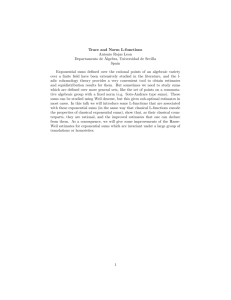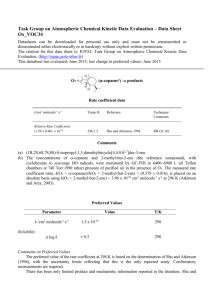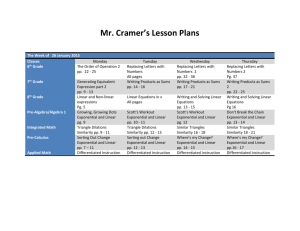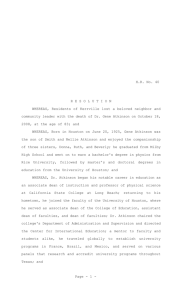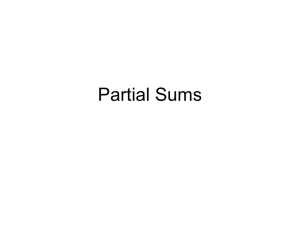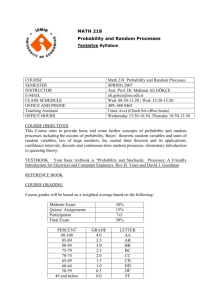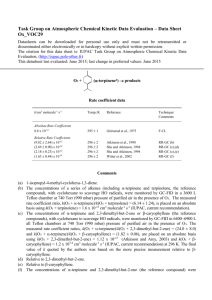lecture notes
advertisement
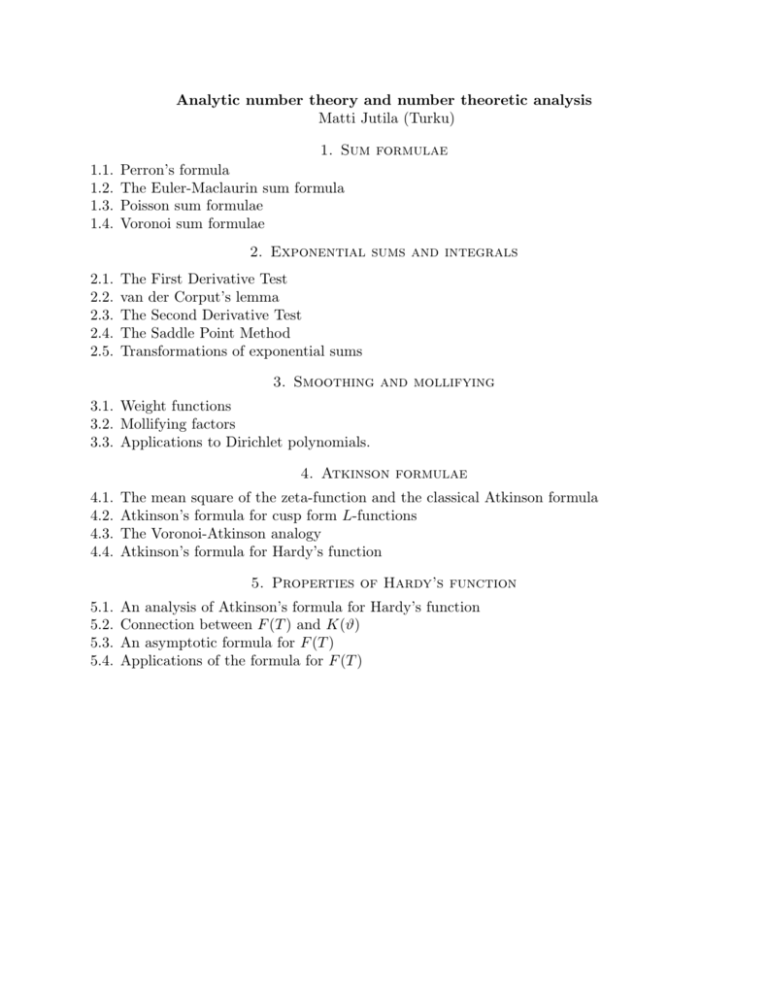
Analytic number theory and number theoretic analysis
Matti Jutila (Turku)
1. Sum formulae
1.1.
1.2.
1.3.
1.4.
Perron’s formula
The Euler-Maclaurin sum formula
Poisson sum formulae
Voronoi sum formulae
2. Exponential sums and integrals
2.1.
2.2.
2.3.
2.4.
2.5.
The First Derivative Test
van der Corput’s lemma
The Second Derivative Test
The Saddle Point Method
Transformations of exponential sums
3. Smoothing and mollifying
3.1. Weight functions
3.2. Mollifying factors
3.3. Applications to Dirichlet polynomials.
4. Atkinson formulae
4.1.
4.2.
4.3.
4.4.
The mean square of the zeta-function and the classical Atkinson formula
Atkinson’s formula for cusp form L-functions
The Voronoi-Atkinson analogy
Atkinson’s formula for Hardy’s function
5. Properties of Hardy’s function
5.1.
5.2.
5.3.
5.4.
An analysis of Atkinson’s formula for Hardy’s function
Connection between F (T ) and K(ϑ)
An asymptotic formula for F (T )
Applications of the formula for F (T )
1. Sum formulae
1.1. Perron’s formula
Given: An arithmetic function a(n), n = 1, 2, ....
Define: The generating function (Dirichlet series)
F (s) =
∞
X
a(n)n−s ,
s = σ + it.
n=1
Suppose: |a(n)| ¿ Φ(n), Φ(n) increasing.
∞
X
|a(n)|n−σ ¿ (σ − 1)−α ,
σ → 1 + 0.
n=1
Problem: To study the sum function
A(x) =
X
a(n).
n≤x
Perron’s formula ([I1], Eq. (A.10)). Let 1 < b ¿ 1, T > 0, x ≥ 1. Then
Z b+iT
1
F (s)xs s−1 ds + O(xb T −1 (b − 1)−α )
A(x) =
2πi b−iT
O(xT −1 Φ(2x) log(2x)) + O(Φ(2x)).
Required: Analytic continuation, singularities and estimates for F (s).
Remark. If we replace the function a(n) of the discrete variable n by a function a(y)
of the continuous variable y, then the integral
Z x
A(x) =
a(y) dy
1
will play the role of the sum function A(x) defined above. The (modified) Mellin transform
Z ∞
F (s) =
a(y)y −s dy
1
then corresponds to the generating function, and there is an analog of Perron’s formula
(see Lukkarinen [Lu], Lemma 2.1). This was the starting point of Lukkarinen’s new proof
of Atkinson’s formula for the mean square of Riemann’s zeta-function.
1.2. The Euler-Maclaurin sum formula
Given: A function f which is continuous in [a, b], with f 0 continuous in (a, b).
Define: The ”row-of-teeth function” ψ(x) = x − [x] − 21 .
The Euler-Maclaurin sum formula. We have
Z b
Z
¯b
X
¯
f (n) =
f (x) dx − ¯ ψ(x)f (x) +
a<n≤b
a
a
b
ψ(x)f 0 (x) dx.
a
Remark 1. There is a more general version involving higher derivatives of f , together
with Bernoulli numbers and polynomials (see [IK], Theorem 4.2).
2
Remark 2. This formula is effective if f is not ”too oscillating”, that is when |f 0 | is
not too large.
Example: For s = σ + it, σ > 1 and for a natural number N , write
ζ(s) =
N
X
X
n−s + lim
X→∞
n=1
n−s .
N <n≤X
Applying Euler-Maclaurin to the latter sum, we get
N
X
ζ(s) =
n−s −
n=1
R∞
N 1−s
− 21 N −s − s N ψ(x)x−s−1 dx.
1−s
This expression makes sense for σ > 0 and gives a meromorphic continuation of ζ(s) to
this half-plane with a simple pole at s = 1. Also, we have
N
X
ζ(s) =
n
−s
n=1
N 1−s
−
+ O((|s| + 1)N −σ ).
1−s
1.3. Poisson sum formulae
As usual, write e(α) = e2πiα . There are various versions of the Poisson summation
formula in literature. The following one involves rather strong conditions and it follows
from Lemma 5.4.2 of [H].
Poisson’s sum formula. Let f (x) be a twice continuously differentiable function of
compact support on the real line. Then
∞
∞ Z ∞
X
X
f (n) =
f (y)e(−ny) dy.
n=−∞
n=−∞
−∞
∞ Z
X
∞
A variant ([J8], Lemma 4).
∞
X
n
(−1) f (n) =
n=−∞
n=−∞
−∞
¢
¡
f (y)e −(n + 12 )y dy.
An interpretation: (−1)n = e( 12 n2 ). This is a special case of e
¡h
kn
2
¢
.
Another variant [J10]. Let h and k be integers with k ≥ 1. Then
µ
¶
Z ∞
∞
∞
³ ny ´
X
h 2
1 X
e
n f (n) =
G(h, n; k)
f (y)e −
dy,
k
k
k
−∞
n=−∞
n=−∞
where
G(a, b; k) =
X
x (mod k)
is a Gaussian sum.
3
µ
e
ax2 + bx
k
¶
Proof: The case h = k = 1 is the ordinary Poisson formula, and the general case can be
easily reduced to that. Namely, our sum equals
µ
¶ X
∞
X
h 2
e
a
f (mk + a)
k
m=−∞
a (mod k)
¶ ∞ Z ∞
µ
X
h 2 X
f (xk + a)e(−nx) dx
=
e
a
k
−∞
n=−∞
a (mod k)
µ
¶ ∞ Z ∞
µ
µ
¶¶
1 X
y−a
h 2 X
=
a
f (y)e −n
dy,
e
k
k
k
n=−∞ −∞
a (mod k)
which gives the claim.
Remark 1. Since G(1, n; 2) = 1 + (−1)n+1 equals 2 for n odd and 0 for n even, the latter
version yields the preceding one.
Remark 2. Note that h and k are not necessarily coprime. Consider Gauss sums
G(h, n; 2k) with (h, k) = 1, so that (h, 2k) = 1 or 2. In the latter case, h = 2h0 is
even, and G(h, n; 2k) = 2G(h0 , n/2; k) if n is even, whereas G(h, n; 2k) = 0 if n is odd (see
[H], Lemma 5.4.5). Thus, after all, we have Gauss sums G(h, n; k) with (h, k) = 1 to deal
with, and then the dependence on n can be controlled by an exponential factor as follows.
As usual, for (h, k) = 1, we define h̄ by hh̄ ≡ 1 (mod k).
Lemma. For (h, k) = 1 and k ≥ 1, the sum G(h, n; k) is equal to
µ
¶
4̄h̄n2
e −
G(h, 0; k) for k odd,
k
µ
¶
h̄(n/2)2
e −
G(h, 0; k) for k and n even,
k
¶
µ
h̄(n2 − 1)/4
G(h, 1; k) for k even and n odd.
e −
k
√
Also, |G(h, n; k)| ≤ 2k.
1.4. Voronoi sum formulae
Let r = h/k, k ≥ 1, (h, k) = 1. Define
D(x, r) =
X
d(n)e(nr).
n≤x
Convention. If x is an integer, then the last term is to be halved.
Definition. For σ > 1, the Estermann zeta-function is defined by the series
E(s, r) =
∞
X
d(n)e(nr)n−s ,
n=1
and elsewhere by analytic continuation.
4
Properties ([J5], Lemma 1.1).
1) Meromorphic continuation to the whole plane with a double pole at s = 1.
2) The functional equation
E(s, h/k) = 2(2π)2s−2 Γ2 (1 − s)k 1−s ×
{E(1 − s, h/k) − cos(πs)E(1 − s, −h/k)}.
Voronoi’s identity ([J5], Theorem 1.6).
D(x, h/k) = k −1 (log x + 2γ − 1 − 2 log k) + E(0, h/k)
1/2
−x
∞
X
√
√
d(n)n−1/2 {e(−nh/k)Y1 (4π nx/k) + (2/π)e(nh/k)K1 (4π nx/k)},
n=1
where γ is Euler’s constant and Y1 , K1 are Bessel functions.
Approximations for Bessel functions ([Le], Sec. 5.11). For x À 1 and a fixed
integer n
1
1
Yn (x) = (2/πx)1/2 sin(x − nπ − π) + O(x−3/2 ),
2
4
1/2 −x
Kn (x) = (π/2x) e (1 + O(x−1 )).
These indicate the following
Approximate Voronoi formula ([J5], Theorem 1.1). For x ≥ 1, k ≤ x, and 1 ≤
N ¿N
X
√
√
d(n)e(−nh/k)n−3/4 cos(4π nx/k − π/4)
∆(x, h/k) = (π 2)−1 k 1/2 x1/4
n≤N
+O(kx1/2+ε N −1/2 ).
Voronoi’s summation formula ([J5], Theorem 1.7). Let 0 < a < b and f ∈ C 1 [a, b].
Then (with the usual convention if a or b is an integer)
Z b
X
−1
d(n)e(nh/k)f (n) = k
(log x + 2γ − 2 log k)f (x) dx
a
a≤n≤b
+k
−1
∞
X
n=1
Z
d(n)
b
√
{−2πe(−nh/k)Y0 (4π nx/k)
a
√
+4e(nh/k)K0 (4π nx/k)}f (x) dx.
Remark. Analogues of the above mentioned results hold if d(n) is replaced by Fourier
coefficients of a (holomorphic or non-holomorphic) cusp form, say by Ramanujan’s function
τ (n) (see [J5], Chapter I, [Me3], Theorem 2).
5
2. Exponential sums and integrals
2.1. The First Derivative Test
Problem. Let f and g be functions on an interval [a, b], with f real. To evaluate (at
least approximately) or to estimate the exponential integral
Z b
I=
g(x)e(f (x)) dx.
a
Considering the real and imaginary parts of g separately, we may suppose that g is real as
well. Suppose that g is of bounded variation on [a, b] with total variation V .
The integral I depends heavily of the (possibly existing) saddle point x0 ∈ [a, b] satisfying
f 0 (x0 ) = 0.
To begin with, let us consider the easy case when no saddle point exists .
The First Derivative Test ([H], Lemma 5.1.2). Suppose that f 0 is monotone and
f 0 (x) ≥ κ > 0 on (a, b). Write
V0 = V + max |g(x)|.
a≤x≤b
Then |I| ≤ V0 /(πκ).
2.2. van der Corput’s lemma
van der Corput’s lemma ([T], Lemma 4.10). Let f 0 (x) be continuous and decreasing
with f 0 (b) = α, f 0 (a) = β. Let g(x) be a real positive function with continuous derivative
and |g 0 (x)| decreasing. Let η ∈ (0, 1) be a constant. Then
Z b
X
X
g(n)e(f (n)) =
g(x)e(f (x) − νx) dx
a<n≤b
α−η<ν<β+η
a
+O(g(a) log(β − α + 2)) + O(|g 0 (a)|).
Proof: Apply Poisson’s summation formula, single out those terms with the index of
summation in the interval (α − η, β + η), and estimate the others by the first derivative
test.
Corollary. Suppose furthermore that |f 0 (x)| ≤ θ < 1. Then
Z b
X
g(n)e(f (n)) =
g(x)e(f (x)) dx + O(g(a) + |g 0 (a)|).
a
a<n≤b
In particular,
X
Z
b
e(f (n)) =
e(f (x)) dx + O(1).
a
a<n≤b
An application to the zeta-function. Let σ ≥ σ0 > 0, t ≥ 10 and x > ct/2π, where
c > 1 is a constant. Then
X
x1−s
+ O(x−σ ).
ζ(s) =
n−s −
1−s
n≤x
6
In particular, if x = ct/2π, then
ζ(s) =
X
n−s + O(t−σ ).
n≤x
Proof: Let N > x, write
ζ(s) =
N
X
n−s −
n=1
=
X
n−s +
n≤x
N 1−s
+ O((|s| + 1)N −σ )
1−s
X
n−s −
x<n≤N
N 1−s
+ O((|s| + 1)N −σ ),
1−s
apply the corollary to the last mentioned sum, and let finally N → ∞.
2.3. The Second Derivative Test.
The Second Derivative Test for exponential integrals ([H], Lemma 5.1.3). Let
f (x) be real and twice differentiable in the interval (a, b) with f 00 (x) ≥ λ > 0. Let g(x) be
real and of total variation V on [a, b]. Write
V0 = V + max |g(x)|.
a≤x≤b
Then
¯Z
¯
¯ b
¯
4V0
¯
¯
g(x)e(f
(x))
dx
¯
¯≤ √ .
¯ a
¯
πλ
√
Proof: Consider, for simplicity, the case g(x) = 1. Let δ = 1/ πλ. If there is a saddlepoint x0 ∈ [a + δ, b − δ], estimate the integral over [x0 − δ, x0 + δ] trivially, and the other
integrals by the first derivative test, observing that |f 0 (x)| ≥ δλ. The other cases as to the
location or existence of x0 are analogous.
Remark. With an explanation of the second derivative test and the saddle point method
in mind, let us consider the Taylor expansion
f (x) = f (x0 ) + f 0 (x0 )(x − x0 ) + 12 f 00 (x0 )(x − x0 )2 + . . . .
Since f 0 (x0 ) = 0, the point e(f (x)) is fairly stationary on the unit circle if |x − x0 | ¿
|f 00 (x0 )|−1/2 . Thus a contribution such as given by the second derivative test seems inevitable. Indeed, this is the point of the saddle point method, which gives this contribution
even in an explicit form.
Using the above result in the van der Corput’s lemma, we obtain an analogous estimate
for exponential sums.
The Second Derivative Test for exponential sums. Let |f 00 | ³ λ in (a, b) and b−a ≥
1. Then
X
e(f (n)) ¿ (b − a)λ1/2 + λ−1/2 .
a<n≤b
7
2.4. The Saddle Point Method
There are various saddle point theorems in literature; here is an example (see [KV], p.
71).
A Saddle Point Theorem. Suppose that the functions f (x) and g(x) satisfy on the
interval [a, b] the following conditions: f (x) is real valued; f (4) (x) and g 00 (x) are continuous;
there exist numbers H, U , and A such that H > 0, A < U , 0 < b − a ≤ U , and
A−1 ¿ f 00 (x) ¿ A−1 ,
g(x) ¿ H,
f (3) (x) ¿ A−1 U −1 ,
g 0 (x) ¿ HU −1 ,
f (4) (x) ¿ A−1 U −2 ,
g 00 (x) ¿ HU −2 .
Suppose that f 0 (x0 ) = 0 for x0 ∈ [a, b]. Then
Z b
g(x0 )e(f (x0 ) + 1/8)
p
+ O(HAU −1 )
g(x)e(f (x)) dx =
00
f (x0 )
a
³
³
´´
³
³
√
√ ´´
+O H min |f 0 (a)|−1 , A + O H min |f 0 (b)|−1 , A .
If x0 does not exist, then the formula holds with the first two terms on the right omitted.
It f 00 < 0, then 1/8 is to be replaced by −1/8 and f 00 (x0 ) is to be replaced by its modulus.
Remark. Delicate cases of this result occur when x0 lies close to a or b; then one of the
error terms becomes comparable with the main term, and we do not get any advantage
over the second derivative test. In practice the saddle point often depends on a parameter,
and if the locations of the saddle point for different values of the parameter are somewhat
evenly distributed, the main term dominates ”mostly”, and the bad cases can be treated as
an error term. A possible device is to introduce a smooth weight function to the integrand.
It causes a certain error, but the error terms can be sharpened; the main term depends
then on the weight function.
2.5. Transformations of exponential sums
van der Corput’s ”Process B”. This means combining van der Corput’s lemma with
the saddle point method to transform exponential sums to a new (better ?) shape. That
is, under suitable conditions,
X
X
e(f (xν ) − νxν − 1/8)
p
g(n)e(f (n)) ≈
g(xν )
,
f 00 (xν )
a<n≤b
α−η<ν<β+η
where f 0 (a) = β, f 0 (b) = α, η ∈ (0, 1) is a constant, and f 0 (xν ) = ν.
Remark 1. The process B is an involution: if it is applied to the new sum, it produces
the original one again. Thus there is no point repeating this process.
Remark 2. ”Process A” means using the ”Weyl shift”. Its effect is to reduce the
original sum to a more tamely oscillation one, at the cost of certain loss of accuracy in the
estimation.
The approximate functional equation for ζ(s) ([I1], Theorem 4.1). Let χ(s) be
as in the functional equation ζ(s) = χ(s)ζ(1 − s), thus
χ(s) = 2s π s−1 sin( 12 πs)Γ(1 − s).
8
Then for t ≥ 1 and σ bounded we have
χ(σ + it) = (2π/t)σ+it−1/2 ei(t+π/4) (1 + O(t−1 )).
Let now 0 < σ < 1, 2πxy = t, x À 1, y À 1. The approximate functional equation is the
formula
X
X
ζ(s) =
n−s + χ(s)
ns−1 + O(x−σ ) + O(t1/2−σ y σ−1 ).
n≤x
n≤y
Proof: Let X = 2(t/2π). We saw earlier that
X
ζ(s) =
n−s + O(t−σ ).
n≤X
Decompose the sum into two parts over [1, x] and (x, X], and transform the latter sum by
process B.
Remark 3. Applying the AFE for two pairs x1 , y1 and x2 , y2 with x1 < x2 , we get,
after a subtraction,
X
X
n−s ≈ χ(s)
ns−1 .
x1 ≤n≤x2
p
y2 ≤n≤y1
If the xi exceed t/2π, then the transformed sum is shorter than the original one. Indeed,
this is the point and advantage of process B ! Such a shortening happens if the original
sum is not too rapidly oscillating, and if this is not the case, process A is helpful.
Process B for exponential sums involving the divisor function.
An exponential sum
X
d(n)g(n)e(f (n))
a<n≤b
can be rewritten by Voronoi’s summation formula (in its classical or generalized version),
and the integrals involving the Bessel function Y0 lead to exponential integrals which can
be treated by the saddle point method, whereas those involving K0 are usually very small
and negligible. Sums involving Fourier coefficients of cusp forms can be treated likewise.
Remark 4. Process A (the Weyl shift) can be applied in this situation, but it leads to
sums of a new type, namely to convolution sums involving coefficients like form d(n)d(n+a),
where the shift a is non-zero. The convolution sums can be treated by the spectral theory of
automorphic functions (this approach is developed in [JM], and [Mo2] is an introduction
to the spectral thery).
The AFE for ζ 2 (s) ([I1], Theorem 4.2). Imitating the proof of the above mentioned
AFE, one may prove its analogue for ζ 2 (s):
X
X
ζ 2 (s) =
d(n)n−s + χ2 (s)
d(n)ns−1 + O(x1/2−σ log t),
n≤x
n≤y
where 4πxy = t2 . Again this gives a transformation formula for Dirichlet polynomials
X
d(n)n−s .
x1 ≤n≤x2
9
A transformation formula for linear exponential sums. Consider sums
X
D(x1 , x2 ; α) =
d(n)e(nα),
x1 ≤n≤x2
where x ≤ x1 < x2 ≤ 2x and α is real with the rational approximation
α=
h
+ η,
k
1 ≤ k ≤ x1/2 ,
0 < |η| ≤ k −2 .
Suppose that k 2 η 2 x À 1; then (see [J4], Thorem 5)
µ
¶
h
h
1
2 2
2 2
−1
D(x1 , x2 ; + η) = (k|η|) D k η x1 , k η x2 ; − − 2
k
k
k η
+O(x1/2 log x).
Writing yi = k 2 η 2 xi , y = k 2 η 2 x, and β = − hk − k12 η , we may restate this relation as follows:
(*)
D(x1 , x2 ; α)
D(y1 , y2 ; β)
=
+ O(log x).
x1/2
y 1/2
We may iterate this relation if β has a suitable rational approximation, which of course is
not certain; it is even possible that β is an integer, say, so that the sum on the right is not
a genuine exponential sum at all !
Suppose that the rational approximation is taken from a Farey series of order K ≤ x1/2 .
Then
|η| ≤ (kK)−1 , k 2 η 2 x ≤ K −2 x,
which means that the transformed sum is shorter than the original one if K = xc , say, for
a positive constant c.
The cusp form case. The situation is analogous but better if d(n) is replaced by
normalized Fourier coefficients a(n) of a holomorphic cusp form of weight k (that is, the
original coefficients are multiplied by n−(k−1)/2 ). Then
X
|a(n)|2 ∼ Ax,
n≤x
where A > 0 is a constant; this follows from a more precise result of Rankin and Selberg.
Then an analogue of (*) holds in the new situation if α is approximated as above by a
fraction from the Farey series of order K = x1/4 . Moreover, the error term O(log x) can
be improved to O(y −a ) for a constant a > 0 (see [J6]). As a corollary, we get an estimate
for the exponential sum
X
a(n)e(nα),
A(x, α) =
n≤x
namely
A(x, α) ¿ x1/2 .
Since
Z
0
1
X
|A(x, α)|2 dα =
n≤x
10
|a(n)|2 ∼ Ax,
this estimate is best possible, up to a constant factor. But an analysis of the corresponding
sum D(x, α) involving the divisor function is still incomplete. Since
Z 1
X
|D(x, α)|2 dα =
d2 (n) ∼ Bx log3 x
0
n≤x
for some constant B > 0, this sum is mostly about of the order
on α is not clear.
√
x, but the dependence
3. Smoothing and mollifying
3.1. Weight functions
Weight functions with slopes. For motivation, let us consider an exponential sum
X
e(f (n))
a≤n≤b
using Poisson’s summation formula. This leads to integrals
Z b
e(f (x) − nx) dx.
a
By the first derivative test, this is ¿ n−1 for large n, and integration by parts shows
that this is in general the true order. Therefore the series in Poisson’s formula is not
absolutely convergent, which is inconvenient in practice. To remedy the situation, we
introduce a weight function w(x) supported in the interval [a, b] such that w(x) = 1 for
x ∈ [a + U, b − U ], where U > 0 (the length of the slopes) is a parameter to be chosen
suitably. We suppose that 0 ≤ w(x) ≤ 1 for all x, and w(j) (x) ¿ U −j for sufficiently many
derivatives. Now the sum
X
w(n)e(f (n))
a≤n≤b
is an approximation for the original sum with an error ¿ U + 1, and Poisson’s formula
leads to integrals
Z b
e(f (x) − nx)w(x) dx.
a
Integration by parts shows that this is ¿ n−2 for large n, and therefore the Poisson series
is absolutely convergent ! The rate of convergence is improved if U is increased, but then
the approximation error also increases, so the choice is U is an optimization problem.
A similar situations occurs in connection with the Voronoi summation. Also, introducing
a weight function to a saddle point integral improves the error estimation, but the leading
term may depend on the weight function.
”Dyadic” weight functions. The smoothing is most efficient if U ³ b − a, but then
the approximation becomes trivial. However, one may construct a good approximation for
the characteristic function of [a, b] using weight functions of the above type, with supports
widening step by step (by factors 2 or so) when we move away from the end points a and
b. Thus if the supports of the first and last weight functions are of length U , then the next
ones are of length 2U and so on. There are about ³ log((b − a)/U ) subsums, and each of
them has ”good” slopes, but the approximation error of the long sum is about U . This is
admissible if U is suitably chosen.
11
3.2. Mollifying factors
Exponential sums involving the divisor function. Consider sums of the type
X
S=
d(n)g(n)e(f (n)).
a≤n≤b
If r is an integer, then of course
S=
X
d(n)g(n)e(f (n) − rn).
a≤n≤b
However, from the point of view of Voronoi’s summation formula, this trivial device is
highly nontrivial, for the shape of the transformed sum depends heavily on r. If r is chosen
so that f 0 (x) ≈ r, then the exponential factor e(f (x) − rx) for the continuous variable x is
more tamely oscillating than e(f (x)), and therefore the extra factor e(−rx) can be viewed
as a mollifier. But it is by no means necessary to restrict r to integers, for if r = h/k is a
rational number, then we may write
X
S=
d(n)g(n)e(rn)e(f (n) − rn),
a<n≤b
and a transformation formula follows from the generalized Voronoi formula related to r
(see [J5], Sec. 3.1).
An argument line this, applied to Dirichlet polynomials, leads to expressions similar to
those occurring in the famous Atkinson formula for the mean square of Riemann’s zetafunction (see [J5], Sec. 4.1). Historically the order was reversed: Atkinson’s formula [A2]
appeared 35 (!) years prior to the transformation formulae.
If d(n) is replaced by normalized Fourier coefficients of a cusp form, then analogous
formulae can be proved by the same argument practically word-by-word.
The procedure of estimating the sum S runs as follows:
1)The sum S is decomposed to subsums according to a system of Farey fractions (and
Farey intervals).
2) The subsums are transformed using Voronoi summation and the saddle point method.
3) The sum of the transformed sums is estimated nontrivially by arguments of the large
sieve type.
Weyl sums. In interesting cases of Weyl sums
X
e(f (n)),
a≤n≤b
the derivative f 0 (x) is too large to be estimated by a rational r = h/k. Therefore we write
e(f (n)) = e(f (n) − 12 rn2 )e( 12 rn2 ),
and apply the ”quadratic” Poisson formula introduced above. The sum is again decomposed according to a system of rational numbers, the condition being
f 0 (n) ≈ rn.
In the case of ”zeta-sums”, this procedure leads again sums of ”Atkinson type”.
12
3.3. Applications to Dirichlet polynomials
Zeta-square sums. Consider Dirichlet polynomials
X
S(M1 , M2 ) =
d(m)m−1/2−it ,
M1 ≤m≤M2
related to the Dirichlet series for ζ 2 (s). Define
φ(x) = arsinh(x1/2 ) + (x + x2 )1/2 .
Then, for small x, we have
1
1
φ(x) = 2x1/2 + x3/2 − x5/2 + · · · .
3
20
Let the δi stand for positive constants which may be assumed to be arbitrarily small. Put
L = log t. The following result is Theorem 4.1 of [J5].
Theorem. Let r = h/k, M1 <
t
2πr
< M2 ,
1/2−δ1
1 ≤ k ¿ M1
Mj =
t
+ (−1)j mj ,
2πr
,
j = 1, 2,
m1 ³ m2 ,
tδ2 max(t1/2 r−1 , hk) ¿ m1 ¿ M11−δ3 ,
nj = h2 m2j Mj−1 .
Then
n
S(M1 , M2 ) = (hk)−1/2 (log(t/2π) + 2γ − log(hk))
+π
1/4
−1/4
(2hkt)
2 X
X
j=1 n<nj
³
1+
µ µ
¶¶
h
1
d(n)e n
−
n−1/4 ×
k
2hk
³
³
³ πn ´ π ´´o
πn ´−1/4
exp i(−1)j−1 2tφ
+
rit χ( 12 + it)
2hkt
2hkt
4
1/2
−1/4
1/2
+O(h−3/2 k 1/2 m−1
L) + O(hm1 t−1/2 L2 ) + O(h−1/4 k 3/4 m1
1 t
L).
Remark. If the decomposition of a ”long” sum is made according to a system of Farey
arcs, then the lengths of the ”short” sums vary considerably. However, it is important at the
final stage of estimation that the lengths of the transformed sums are of the same order of
magnitude. Indeed, if the Farey sequence in question is of order K, then mj ³ tk(h2 K)−1
and nj ³ M1 K −2 .
Zeta-sums. Let
X
S=
n−1/2−it .
N1 ≤n≤N2
13
Theorem. Let t be a large positive number, N1 ³ N2 , and
t1/3 ¿ N1 ¿ t1/2 .
Let r = h/k be a rational number with 1 ≤ k ¿ N1 and (h, k) = 1 such that
r
t
N1 <
< N2 .
2πr
Write
t
t
N12 =
− m1 , N22 =
+ m2 ,
2πr
2πr
and suppose that m1 ³ m2 . Suppose further that
N1 tδ1 ¿ m1 ¿ N12 t−δ2 .
Write
Then
nj = h2 m2j Nj−2 for j = 1, 2.
µ ¶it/2 µ
¶
π 1/4
h
1 it
−1/4
S = 1/2 (2hkt)
χ
+
×
2k
2
2
2k
µ
¶−1/4
2
n
X
X
πn2
j
×
G(−h, 0; 2k) +
G(−h, (−1) n; 2k) 1 +
8hkt
√
j=1 1≤n≤2 nj
µ
µ 2¶
¶
πn
πin2 o
−1/2 ε
j−1
exp i(−1) tφ
−
+ O(k 1/2 N1
t ).
8hkt
8hk
Remark 1. Short zeta-sums of the above type appeared in the Bombieri-Iwaniec
method. It is now a challenging task to attack the Lindelöf problem (estimation of the
zeta-function on the critical line) using the new ”Atkinson-transformation”. At least we
get (as in the Bombieri-Iwaniec method) local information on short zeta-sums.
Remark 2. If r is taken from a Farey series of order K and S corresponds to the
respective Farey arc (that is, t/(2πn2 ) runs over the Farey arc for N1 ≤ n ≤ N2 ), then
nj ³ N12 K −2
independently of r. Also,
N2 − N1 ³ N1 (hK)−1 .
Therefore the heuristic expectation for |S| is about (hK)−1/2 . The same follows from the
1/4
theorem if we suppose that there is a saving by a factor nj in the n-sum over the trivial
estimate. The sum over h and k of the heuristic estimates of short zeta-sums gives the
hypothetical estimate
¿ Kt1/2 N −1
for a long zeta-sum, where n ³ N . In particular, with K = N t−1/3 , this gives the classical
bound ¿ t1/6 , and then the argument is unconditional. The problem now is to reduce the
size of K and to keep the estimations still unconditional.
4. Atkinson formulae
14
4.1. The mean square of the zeta-function
and the classical Atkinson formula
The asymptotic formula for the mean square:
Z T
1
I(T ) =
|ζ( + it)|2 dt = (log(T /2π) + 2γ − 1)T + E(T ).
2
0
Estimates for E(T ): let E(T ) = O(T c+ε ). Then
c = 3/4 Littlewood 1922,
= 1/2 Ingham 1927, Atkinson 1939,
= 5/12 Titchmarsh 1934,
= 1/3 Balasubramanian [B] 1978, Heath-Brown 1979, MJ [J1] 1983
= 7/22 Heath-Brown and Huxley [H-BH] 1990.
Approaches to E(T ):
• Approximate functional equation for ζ(s) (Hardy-Littlewood, Ingham, Titchmarsh, Balasubramanian).
• Connection of I(T ) with the divisor problem (Atkinson [A1] 1939):
I(T ) = 2πD(T /2π) + O(T 1/2+ε ).
• Atkinson’s formula (Atkinson [A2] 1949, MJ [J1-J2] 1983, 1993).
Atkinson’s formula ([A2]). Let N ³ T and
µ 2
¶1/2
T
N
N
NT
0
N =
+
−
+
.
2π
2
4
2π
Then
E(T ) = Σ1 (T ) + Σ2 (T ) + O(log2 T ),
µ ¶1/4 X
√
T
(−1)n d(n)n−3/4 e(T, n) cos(f (T, n)),
Σ1 (T ) = 2
2π
n≤N
µ µ
¶¶−1
X
T
−1/2
Σ2 (T ) = −2
d(n)n
log
cos(g(T, n)),
2πn
0
n≤N
(µ ¶
µ³ ´ ¶)−1
1/2
³
πn ´−1/4
2T
πn 1/2
e(T, n) = 1 +
ar sinh
2T
πn
2T
= 1 + O(n/T ),
µ³ ´ ¶
πn 1/2
f (T, n) = 2T ar sinh
+ (π 2 n2 + 2πnT )1/2 − π/4
2T
p
= 4π nT /2π − π/4 + O(n3/2 T −1/2 ),
µ
¶
T
g(T, n) = T log
− T + π/4.
2πn
15
Idea of the proof. The starting point is the ”Atkinson dissection”: for Re u, Re v > 1,
we have
∞ X
∞
X
ζ(u)ζ(v) =
m−u n−v = ζ(u + v) + f (u, v) + f (v, u),
m=1 n=1
f (u, v) =
∞ X
∞
X
r−u (r + s)−v .
r=1 s=1
This formula is analytically continued inside the critical strip, in particular to u =
v = 12 − it, and integration over t yields a formula for I(T ).
Main ingredients of the argument:
• Poisson’s summation formula (cf. van der Corput’s method).
• Voronoi’s formula for D(x) (or for the error term ∆(x)).
• The saddle point method.
1
2
+ it,
Other proofs. Motohashi [Mo1] (Riemann-Siegel formula), Jutila [J7] (Laplace transforms), Lukkarinen [Lu] (Mellin transforms).
Some applications.
• The order of E(T ) (mentioned above).
• The mean square for E(T ):
Z T
E 2 (t) dt = cT 3/2 + F (T ).
2
Here
F (T ) ¿ T 5/4 log2 T (Heath-Brown [H-B1] 1978)
¿ T log5 T (Motohashi [Mo1] 1986, Meurman [Me2] 1987),
¿ T log4 T (Preissmann [P] 1988).
• The twelfth power moment (Heath-Brown [H-B2] 1978)
Z T
1
|ζ( + it)|12 dt ¿ T 2 log17 T.
2
0
Here Atkinson’s formula may be replaced by transformation formulae for Dirichlet polynomials involving the divisor function (there are also analogous results involving Fourier
coefficients of cusp forms, see [J5], [Me3])
• Omega-estimates for E(T ): Hafner-Ivić [HI] 1989.
• Connection between E(T ) and ∆(x) (see [J1-2]):
E(T ) ≈ 2π∆∗ (T /2π),
where
1
∆∗ (x) = −∆(x) + 2∆(2x) − ∆(4x).
2
More precisely, for
E ∗ (t) = E(t) − 2π∆∗ (t/2π),
16
we have the mean square estimate [J3]
Z T
E ∗ (t)2 dt ¿ T 4/3 log3 T,
0
which should be compared with the corresponding formula for E(t). Still more precisely,
Ivić [I4] refined this estimate to an asymptotic formula with an error term O(T 7/6+ε ).
This shows that the estimate if of the true order. The point is that the Voronoi formula
for ∆∗ (x) is analogous to that for ∆(x) except that there are factors (−1)n as in Atkinson’s
formula. Also,
1 X
(−1)n d(n) = (log x + 2γ − 1)x + ∆∗ (x).
2
n≤4x
The Laplace
Re p > 0)
transform
of
E(t).
Z
Define the Laplace transforms (for
∞
1
|ζ( + it)|2 e−pt dt,
2
0
Z ∞
M (p) =
E(t)e−pt dt.
L(p) =
0
Then
µ
¶
log(2πp) − γ
L(p) +
.
p
−1
M (p) = p
Now the Laplace inversion gives
1
E(T ) =
2πi
Z
M (p)epT dp
(a > 0).
(a)
The following lemma is essentially due to Atkinson [A1].
Lemma. In the strip 0 < Re p < π, we have
³
³π
´ ´
L(p) = −ie(1/2)ip log 2π − γ +
−p i
2
∞
X
+2πe−(1/2)ip
d(n)e(−ne−ip ) + λ(p),
n=1
where the function λ(p) is holomorphic even in the strip |Re p| < π. Moreover, in any
strip |Re p| ≤ θ with 0 < θ < π, we have
λ(p) ¿ (|p| + 1)−A
for any fixed A > 0, where the implied constant depends on θ and A.
Corollary.
³
³π
´ ´
M (p) = −p−1 ie(1/2)ip log 2π − γ +
− p i + p−1 λ(p)
2
∞
X
+2πp−1 e−(1/2)ip
d(n)e(−ne−ip ) + p−2 (log(2πp) − γ).
n=1
17
An alternative proof of Atkinson’s formula [J7]. Let a = T −1 . The Laplace
inversion gives
E(T ) = Re (E1 (T ) + E2 (T ) + E3 (T )) ,
where
1
E1 (T ) = −
π
Z
³
³π
´ ´
p−1 e(1/2)ip log 2π − γ +
− p i epT dp,
2
a
Z a+i∞
1
p−1 λ(p)epT dp,
E2 (T ) =
πi a
Z a+i∞
1
E3 (T ) =
p−1 F (p)epT dp
πi a
a+i∞
with
F (p) = 2πe
−(1/2)ip
∞
X
d(n)e(−ne−ip ) + p−1 (log(2πp) − γ).
n=1
Here
E1 (T ), E2 (T ) ¿ log T.
Further, the series involving d(n) in F (p) gives the main contribution and produces the
sums Σ1 , Σ2 in Atkinson’s formula.
Remark. This approach to Atkinson’s formula, unlike Atkinson’s argument, is based
on functional relations (functional equations, summation formulae) rather than special
properties of the divisor function, and therefore it is applicable in other cases such as
cusp form L-functions and Hardy’s function. Also, Atkinson’s formula can generalized to
L-functions [Me1].
4.2. Atkinson’s formula for cusp form L-functions
Let
ϕ(s) =
∞
X
c(n)n−s
n=1
be the L-function attached to a holomorphic cusp form of weight k for the full modular
group. We suppose that the cusp form in question in an eigenfunction of all Hecke operators, so its Fourier coefficients c(n), normalized to run over the corresponding eigenvalues,
are real and multiplicative. The function ϕ(s) may be continued to an entire function
satisfying Hecke’s functional equation ϕ(s) = (−1)k/2 ψ(s)ϕ(k − s) with
ψ(s) = (2π)2s−k Γ(k − s)/Γ(s).
The function
k
k
+ it)−1/2 ϕ( + it)
2
2
2
is real for real t and corresponds to the function Z (t) in the theory of the zeta-function,
where
1
1
Z(t) = χ( + it)−1/2 ζ( + it)
2
2
is Hardy’s function, also real for real t.
Zϕ (t) = i−k/2 ψ(
18
Define
Z
T
Eϕ (T ) =
Zϕ (t) dt.
0
Note that Eϕ (T ) corresponds to E(T ) because there is no main term for the mean value
of Zϕ (t).
”Normalized” coefficients:
a(n) = c(n)n−(k−1)/2 .
Then
ϕ̃(s) =
∞
X
a(n)n−s = ϕ(s + (k − 1)/2)
n=1
2
corresponds to ζ (s) and satisfies the functional equation
ϕ̃(s) = (−1)k/2 ψ̃(s)ϕ̃(1 − s),
where
ψ̃(s) = ψ(s + (k − 1)/2) = (2π)2s−1
Γ(1 − s + (k − 1)/2)
.
Γ(s + (k − 1)/2)
Then
1
1
Zϕ (t) = i−k/2 ψ̃( + it)−1/2 ϕ̃( + it),
2
2
in analogy with the definition of Z(t).
Atkinson’s formula for cusp form L-functions:
Eϕ (T ) = Σ1,ϕ (T ) + Σ2,ϕ (T ) + O(log2 T ),
where the sums Σj,ϕ (T ) (j = 1, 2) are defined as the Σj (T ) in the original Atkinson formula
except that the coefficients d(n) are to be replaced everywhere by a(n).
Remark. The same argument also yields a formula of the Atkinson type for L-functions
attached to non-holomorphic cusp forms (or Maass wave forms).
4.3. The Voronoi-Atkinson analogy
The Atkinson-Voronoi comparison. The Voronoi formula for
X
A(x) =
a(n)
n≤x
is
A(x) =
√
x1/4 X
√
a(n)n−3/4 cos(4π nx − π/4) + O(x1/2+ε N −1/2 ),
π 2 n≤N
where 1 ≤ N ¿ x. Then
A∗ (x) = −A(x) + a(2)A(2x) − 21 A(4x)
corresponds to
mentioned above. Thus
1
∆∗ (x) = −∆(x) + 2∆(2x) − ∆(4x)
2
Eϕ (T ) ≈ 2πA∗ (T /2π).
19
For instance, as an analog of the estimate [J3]
Z T
(E(t) − 2π∆∗ (t/2π))2 dt ¿ T 4/3 log3 T
2
we have
Z
T
(Eϕ (t) − 2πA∗ (t/2π))2 dt ¿ T 4/3 log3 T.
2
Likewise, an analog of
E(T ) ¿ T 1/3+ε
should be
Eϕ (T ) ¿ T 1/3+ε ,
but the proof of the former estimate via Atkinson’s formula breaks down in the latter case,
because Zϕ (t) is of variable sign. Thus the last mentioned estimate is presently an open
problem !
Some heuristics. Let us ignore the error term O(n3/2 T −1/2 ) in the approximation for
f (T, n). Then Lindelöf ’s hypothesis ζ( 21 + it) ¿ tε would follow as a consequence of the
well-known estimate d(n) ¿ nε . But how to take into account this error term ? We may
turn the power n3/2 to n1/2 (occurring in the first term) by Fourier analysis.
We make use of the Airy function
Z
1 ∞
cos(Ay 3 − 2πuy) dy.
β(u) =
π 0
It can be expressed in terms of J- ja K-Bessel functions as follows:
¶
µ
|2πu|1/2
2|2πu|3/2
√
β(u) =
(u < 0),
K1/3
3πA1/2
3 3A
µ
¶
¶¶
µ
µ
(2πu)1/2
2(2πu)3/2
2(2πu)3/2
√
√
β(u) = √
J1/3
+ J−1/3
(u > 0).
3 3A1/2
3 3A
3 3A
Lemma [J2]. Let A > 0, B, C and y be real. Then
Z ∞
3
cos(Ay + By + C) = 2π
β(u) cos((B + 2πu)y + C) du.
−∞
√
Connection between ∆(x) and E(T ) [J2]. Apply the lemma with y = n. Then
E(T ) turns to something like 2π∆∗ (T /2π), and an analysis of this analogy shows that
∆(x) ¿ xα =⇒ E(T ) ¿ T (1+2α)/5 (log T )12/5 .
In particular, if α = 1/4 + ε is admissible, then
E(T ) ¿ T 3/10+ε ,
ζ( 12 + it) ¿ t3/20+ε .
Remark. As a matter of fact, the estimation of E(T ) depends on the behavior of d(n)
in a neighbourhood of 2T /π. Suppose that
∆(x + y) − ∆(x) ¿ y 1/2 xε .
20
This very strong conjecture can be motivated by probabilistic considerations (if we view
the deviation of d(n) from its expectation as a ”random variable”). Then it would follow
that
ζ( 12 + it) ¿ t1/8+ε .
4.4. Atkinson’s formula for Hardy’s function
Theorem [J8]. Let T be a large positive number, N ³ T , and N 0 as in Atkinson’s
formula. Then
¡
¢
F (T ) = S1 (T ) + S2 (T ) + O log2 T ,
where
¶2 !
µ
1
S1 (T ) = 2 2(T /4π)1/4
(−1)n(n+1)/2 e T, n +
2
√
n≤ N
Ã
à µ
!
µ
¶−1
¶2 !
1
1
1
× n+
cos
f T, n +
− 3π/8
2
2
2
and
S2 (T ) = −4
X
√
n≤ N 0
Ã
X
√
n
−1/2
¡
¢−1
log(T /2πn )
cos
2
µ
¶
¢
1 ¡
2
g T, n + π/4 .
2
Steps of the proof.
- A formula for the Laplace transform of Z(t),
- An analysis of the Laplace inversion integral using the saddle-point method and Poisson’s
summation formula.
Mean-value result.
Z
T
F 2 (t) dt ∼ c0 T 3/2 .
0
Corollary:
F (T ) = Ω(T 1/4 ).
The Laplace transform of Z(t).
Define
Z
L(p) =
∞
Z(t)e−pt dt.
0
An auxiliary function:
√
H(s) = 2π −1/4−s/2 cos(πs/4)χ(s)1/2 Γ(s/2 + 1/4).
¡
¢
¡
¢
1
1
H( + it) = 1 + O (|t| + 1)−1 , H 0 ( + it) ¿ (|t| + 1)−2
2
2
A modified Laplace transform:
Z ∞
1
L̃(p) =
Z(t)H( + it)e−pt dt,
2
0
L̃(p) ≈ L(p).
21
Lemma. For 0 < Re p < π/2, we have
√
L̃(p) = − 2π 1/4 e−πi/4 eip/2 Γ(3/4)
∞
X
√
¡
¢
πi/8 −ip
+2 2πe
e
n1/2 exp −πin2 e−2ip + λ(p),
n=1
where λ(p) is holomorphic even in the strip |Re p| < π/2. Moreover, in any strip |Re p| ≤ θ
with 0 < θ < π/2, we have
λ(p) ¿ (|p| + 1)−1 .
5. Properties of Hardy’s function
5.1. An analysis of Atkinson’s formula for Hardy’s function
In view of well-known estimates for ”zeta-sums”, we have
S2 (T ) = O(T 1/6 ).
It remains to deal with S1 (T ). The coefficients e(T, (n + 12 )2 ) ≈ 1 can be ignored. Further,
¡
¢
cos 12 f (T, (n + 12 )2 ) − 3π/8
¢¢
¡
¡
= (−1)L sin 2π(n + 12 )ϑ + A(n + 12 )3 + O (n + 21 )5 T −3/2 ,
√
1
where A = 12
2π 3 T −1/2 . Let
√
bn = 2 2(−1)n(n+1)/2 (n + 12 )−1 .
If we ignore the error term and the term involving A in sin(...), we reduce S1 (T ) heuristically to the Fourier series
∞
X
bn sin(2π(n + 21 )ϑ).
n=0
Question: Which function has such a Fourier series ?
To answer this question, define
for 0 ≤ x < 1/4 and 3/4 < x ≤ 1,
0
K(x) =
π
for x = 1/4 or 3/4,
2π for 1/4 < x < 3/4.
Then K(ϑ) extended to an odd periodic function with period 2 has the above mentioned
Fourier series.
5.2. Connection between F (T ) and K(ϑ)
Theorem (M. A. Korolev [K]). Let ϑ ∈ [0, 1) be fixed and L a natural number. Let
K0 (x) for x ∈ [0, 1] be as K(x) except that K0 (1/4) = 4π/3 and K0 (3/4) = 2π/3. Then
F (2π(L + ϑ)2 ) = (−1)L K0 (ϑ)L1/2 + Oϑ (L1/3 log L).
p
p
Thus if T = 2π(L + ϑ)2 , then L = [ T /2π], ϑ = { T /2π}, and
F (T ) = (−1)L (T /2π)1/4 K0 (ϑ) + Oϑ (T 1/6 log T ).
22
Theorem [J8]. Define ϑ0 = min(|ϑ − 1/4|, |ϑ − 3/4|). If ϑ0 6= 0, then
F (T ) = (−1)L (T /2π)1/4 K(ϑ) + O(T 1/6 log T )
³
³
´´
1/4
−1/8 −3/4
+O T
min 1, T
ϑ0
,
and if ϑ0 = 0, then the result of Korolev’s theorem holds for F (T ).
Remark. In the ”critical interval” 0 < ϑ0 ¿ T −1/6 , the second error term is comparable
with the leading term. To get a genuine error term uniformly, we have to modify the
leading term (the step function K0 (ϑ) will be replaced by a certain smooth function K̃(ϑ)).
The length of a critical interval in the parameter T is ³ T 1/3 , and the distance between
consecutive critical intervals is ³ T 1/2 .
Corollary. F (T ) = O(T 1/4 ), F (T ) = Ω± (T 1/4 ).
5.3. An asymptotic formula for F (T )
Problem. To extract a main term for F (T ) for all T .
Definition. Let w(u) be a smooth non-negative weight function such that w(u) = 1 for
|u| ≤ 1/4 and w(u) = 0 for |u| ≥ 1/2. Define a modification of the step function K(x) as
follows:
Z 1/2
K̃(ϑ) = K(ϑ) + 2π
w(u)β(u)(K(ϑ + u) − K(ϑ))du,
−1/2
Remark. The term involving the u-integral can be viewed as a ”correction term”. If ϑ is
not close to the jump points 1/4, 3/4 of K(ϑ), then this correction is small (since either
β(u) is exponentially small or it oscillates). On the other hand, the correction is significant
if ϑ0 ¿ T −1/6 and its role is to ”smooth out” the jumps of K(ϑ). The formulae
Z 1/2
2
2π
w(u)β(u) du = + O(T −1/8 ),
3
0
Z 0
1
2π
w(u)β(u) du = + O(T −1/8 )
3
−1/2
indicate the jumps of F (T ) and also the asymmetry of the jumps. The underlying formulae
from the Bessel function theory are
Z ∞
2
2π
β(u) du = ,
3
0
Z 0
1
2π
β(u) du = .
3
−∞
Theorem [J9].
F (T ) = (−1)L (T /2π)1/4 K̃(ϑ) + O(T 1/6 log T ).
23
5.4. Applications of the formulae for F (T )
1) Quasiperiodicity:
F (2π(τ + 2)2 ) = F (2πτ 2 ) + O(T 1/6 log T ),
where T = 2πτ 2 . On the other hand,
|F (2π(n + 12 )2 ) − F (2π(n − 12 )2 )| = 4π(T /2π)1/4 + O(T 1/6 log T,
where T = 2πn2 and n is a natural number.
2) The jumps of F (T ) and the asymmetry of Z(t):
|F (2π(n +
j
j
+ ϑ0 )2 ) − F (2π(n + − ϑ0 )2 )| À T 1/4
4
4
if n is an integer, j = 1, 3, T = 2πn2 and ϑ0 ³ T −1/6 . Hence the mean value of Z(t) over
the interval
j
j
[2π(n + − ϑ0 )2 , 2π(n + + ϑ0 )2 ]
4
4
−1/12
is ³ T
(and Z(t) ”pulls” in the positive or negative direction); the length of such an
interval is ³ T 1/3 ).
Problems:
1) What about shorter intervals, that is how the asymmetry can be localized ?
2) What is the true order of the error term in the asymptotic formula for F (T ) ?
24
References
[A1] F. V. Atkinson, The mean value of the zeta-function on the critical line, Quart. J. Math. Oxford
10 (1939), 122–128.
[A2] F. V. Atkinson, The mean value of the Riemann zeta-function, Acta Math. 81 (1949), 353 – 376.
[B] R. Balasubramanian, An improvement on a theorem of Titchmarsh on the mean square of |ζ( 21 +it)|,
Proc. London Math. Soc. (3) 36 (1978), 540–576.
[HI] J. L. Hafner and A. Ivić, On the mean square of the Riemann zeta-function on the critical line, J.
Number Theory 32 (1989), 151–191.
[H-B1] D. R. Heath-Brown, The mean value for the Riemann zeta-function, Mathematika 25 (1978),
177–184.
[H-B2] D. R. Heath-Brown, The twelfth power moment of the Riemann zeta-function, Quart. J. Math.
Oxford (2) 29 (1978), 443–462.
[H-BH] D. R. Heath-Brown and M. N. Huxley, Exponential sums with a difference, Proc. London Math.
Soc. (3) 61 (1990), 227–250.
[H] M. N. Huxley, “Area, Lattice Points, and Exponential Sums,” Clarendon Press, Oxford, 1996.
[I1] A. Ivić, “The Riemann Zeta-function,” John Wiley & Sons, Inc., New York, 1985.
[I2] A. Ivić, “Lectures on Mean Values of the Riemann Zeta Function,” Tata Lectures on Mathematics
and Physics, vol. 82, published by Springer-Verlag for the Tata Institute of Fundamental Research,
1991.
[I3] A. Ivić, On the integral of Hardy’s function, Arch. Math. 83 (2004), 41–47.
[I4] A. Ivić, On the mean square of the zeta-function and the divisor problem, Ann. Acad. Sci. Fenn.
Mathematica 23 (2007), 1–9.
[IK] H. Iwaniec and E. Kowalski, “Analytic Number Theory,” American Mathematical Society, Providence, Rhode Island,, 2004.
[J1] M. Jutila, Riemann’s zeta-function and the divisor problem, Ark. Mat. 21 (1983), 75–96.
[J2] M. Jutila, Riemann’s zeta-function and the divisor problem. II, Ark. Mat. 31 (1993), 61–70.
[J3] M. Jutila, On a formula of Atkinson, in “Coll. Math. Soc. János Bolyai 34. Topics in Classical
Number Theory, Budapest 1981,” North-Holland, Amsterdam, 1984, pp. 807–823.
[J4] M. Jutila, On exponential sums involving the divisor function, J. Reine Angew. Math. 355 (1985),
173–190.
[J5] M. Jutila, “Lectures on a method in the theory of exponential sums,” Tata Lectures on Mathematics
and Physics, vol. 80, published by Springer-Verlag for the Tata Institute of Fundamental Research,
1987.
[J6] M. Jutila, On exponential sums involving the Ramanujan function, Proc. Indian Acad. Sci. (Math.
Sci.) 97 (1987), 157–166.
[J7] M. Jutila, Atkinson’s formula revisited, in “Voronoi’s impact on modern science, Book 1,” Institute
of Mathematics, National Academy of Sciences of Ukraine, Kyiv, 1998, pp. 137–154.
[J8] M. Jutila, Atkinson’s formula for Hardy’s function, J. Number Theory 129 (2009), 2853–2878.
[J9] M. Jutila, An asymptotic formula for the primitive of Hardy’s function, Ark. Mat. 49 (2011),
97–107.
[J10] M. Jutila, Transformations of zeta-sums, preprint.
[JM] M. Jutila and Y. Motohashi, Mean value estimates for exponential sums and L-functions: a
spectral theoretic approach, J. Reine Angew. Math. 459 (1955), 61–87.
[KV] A. A. Karatsuba and S. M. Voronin, “The Riemann Zeta-Function,” Walter de Gruyter, Berlin-New
York, 1992.
[K] M. A. Korolev, On the integral of Hardy’s function Z(t), Izv. Ross. Akad. Nauk, Ser. Mat. 72
(2008), 19–68.
[Le] N. N. Lebedev, “Special functions and their applications,” Dover Publications Inc., New York,
1972.
[Lu] M. Lukkarinen, The Mellin transform of the square of Riemann’s zeta-function and Atkinson’s
formula, 74 pp, Ann. Acad. Sci. Fenn. Math. Diss. 140 (2005).
25
[Me1] T. Meurman, A generalization of Atkinson’s formula to L-functions, Acta Arith. 47 (1986),
351–370.
[Me2] T. Meurman, On the mean square of the Riemann zeta-function, Quart. J. Math. Oxford (2) 38
(1987), 337–343.
[Me 3] T. Meurman, On exponential sums involving the Fourier coefficients of Maass wave forms, J.
Reine Angew. Math. 384 (1988).
[Me4] T. Meurman, On the order of the Maass L-function on the critical line, in “Coll. Math. Soc.
János Bolyai 51. Number Theory, Budapest 1987,” North-Holland, 1989 pages 325–354.
[Mo1] Y. Motohashi, “Riemann-Siegel formula,” University of Colorado, Boulder, 1987.
[Mo2] Y. Motohashi, “Spectral theory of the Riemann zeta-function,” Cambridge Univ. Press, Cambridge, 1997.
[P] E. Preissmann, Sur la moyenne de la fonction zeta, in “Analytic Number Theory and Related
Topics,” World Scientific, 1993, pp. 119-125.
[T] E. C. Titchmarsh, “The Theory of the Riemann Zeta-function,” (2nd ed., revised by D. R. Heath-Brown),
Clarendon Press, Oxford, 1986.
26
